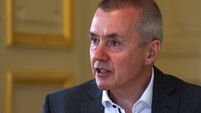Oliver Mangan: The US dollar has had the upper hand over the summer

The high US rate environment is providing considerable support for the dollar, helping it to make ground over the summer.
Although the US dollar has retreated from last year’s peaks, which saw it reach its highest point on a trade-weighted basis in 20 years, it has remained at very elevated levels in 2023.
The euro has moved in a $1.05-$1.12 range so far this year, while sterling has largely traded in a $1.20-1.31 corridor. These are low ranges for both currencies against the dollar in the context of their trading levels for most of the last two decades.
Similarly, the Australian, New Zealand and Canadian dollars are also trading at relatively weak levels against the US currency.
The dollar has had the upper hand over the summer, with both the euro and sterling hitting three-month lows of $1.07 and $1.245, respectively, in the past week.
Meanwhile, both the Japanese yen and Chinese yuan have fallen to very low levels against the dollar recently. The continuing strength of the dollar is very much linked to the ongoing impressive performance of the US economy and relatively high US interest rates.
US data have generally surprised to the upside in 2023, and the anticipated slowdown in the economy has not materialised to date.
Indeed, US GDP growth this year is now likely to be broadly on par with the 2.1% rate recorded in 2022.
Meantime, the labour market remains very tight, with the jobless rate close to 50-year lows. In contrast, both the eurozone and UK economies have struggled in the past year, narrowly avoiding recession.
While US GDP was 2.6% higher in the second quarter than a year earlier, growth in the eurozone and UK was negligible over the same 12-month period, at circa 0.5%.
Against this backdrop, the Fed has raised rates by 525bps to a 5.25%-5.50% range. Markets are undecided as to whether this is the peak or if there will be one final 25bps rate hike before year-end.
More importantly, though, the Fed is guiding it will need to keep monetary policy restrictive for an extended period of time. Although headline inflation has fallen back, core inflation remains well above its 2% target. As a result, US interest rates will need to remain higher for longer.
This has seen markets scale back their expectations for US rate cuts. Futures contracts now point to rates being cut to 4.5% by the end of 2024 and just below 4% by the end of 2025.
In early summer, US rates were expected to fall back to 3%. This hardening of interest rate expectations has put upward pressure on US bond yields, with 10-year yields testing 15-year highs recently, above 4.3%.
The high US rate environment is providing considerable support for the dollar, helping it to make ground over the summer.
Further near-term gains by the dollar, though, may be difficult to achieve as there is strong technical support for the euro in the $1.05-$1.07 range and at $1.20-$1.24 for sterling.
The performance of the dollar in 2024 will likely be heavily influenced by the timing and scale of any monetary policy easing by the Fed.
In particular, the dollar would most probably lose ground next year should there be a narrowing of interest rate spreads between it and other currencies.
Right now, though, this looks a considerable way off, so the dollar is likely to remain at elevated levels for some time yet.
- Oliver Mangan is chief economist with AIB











